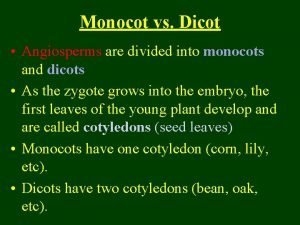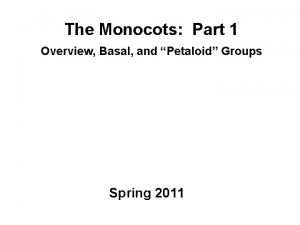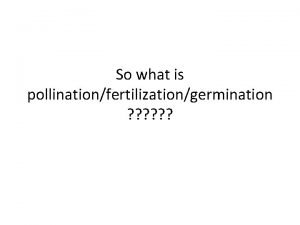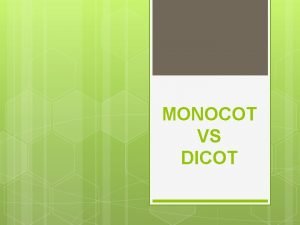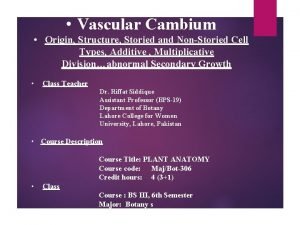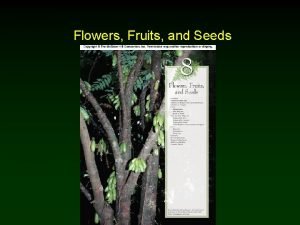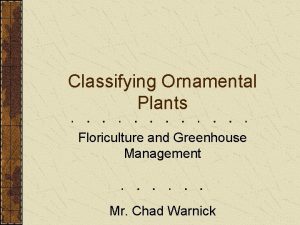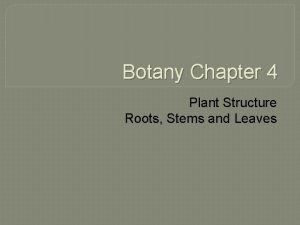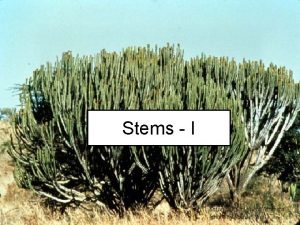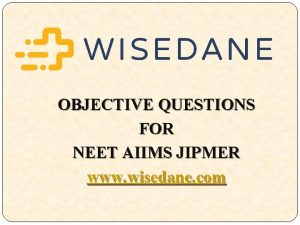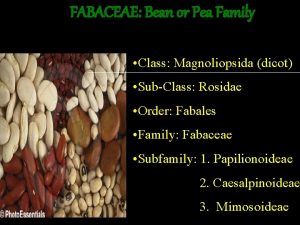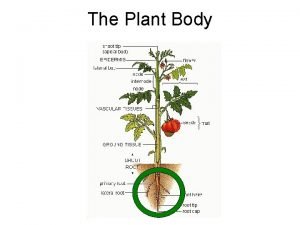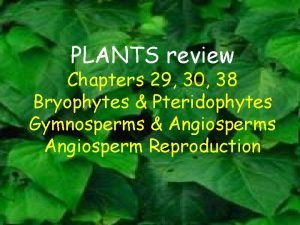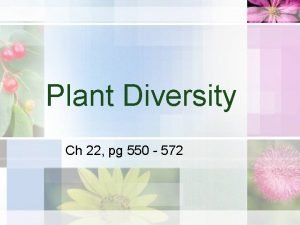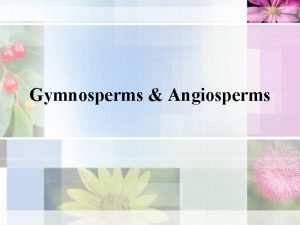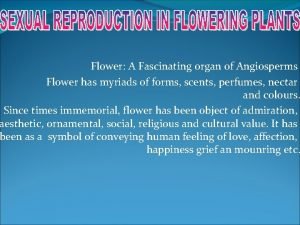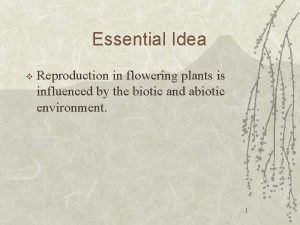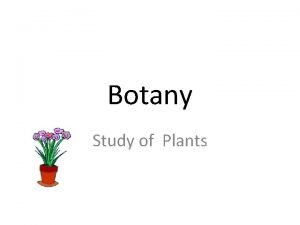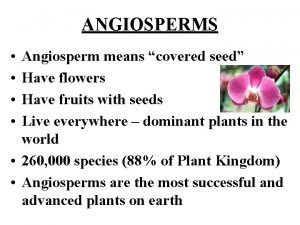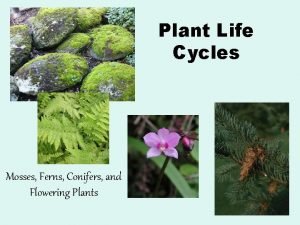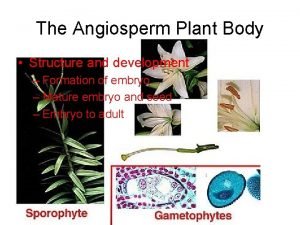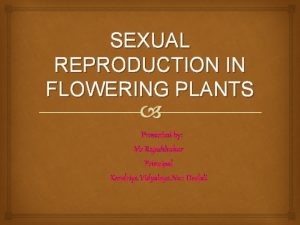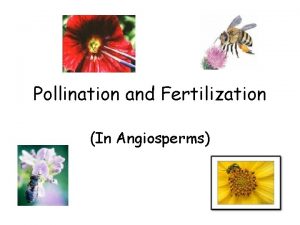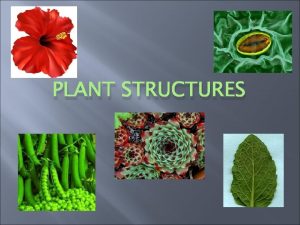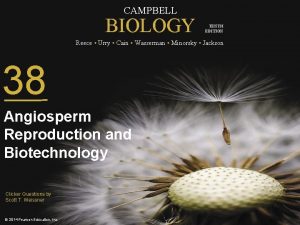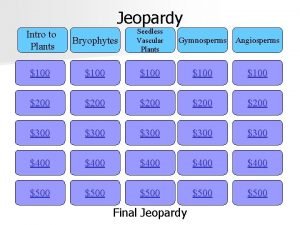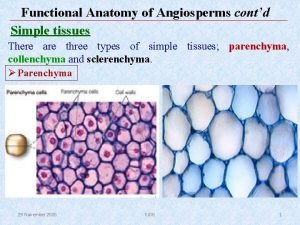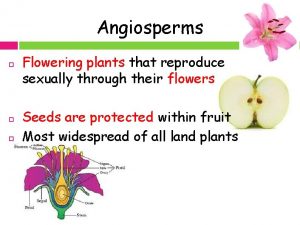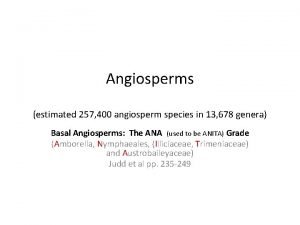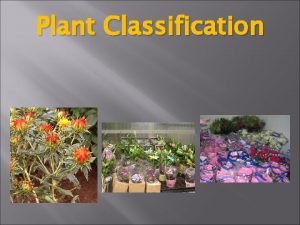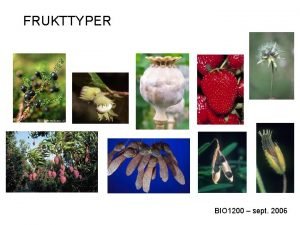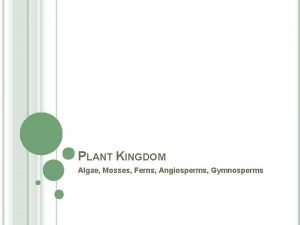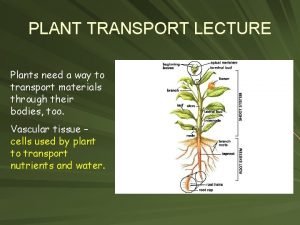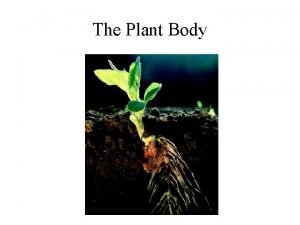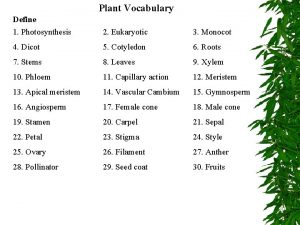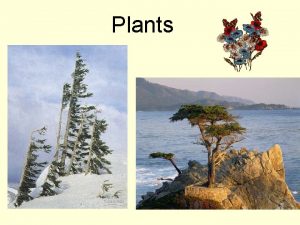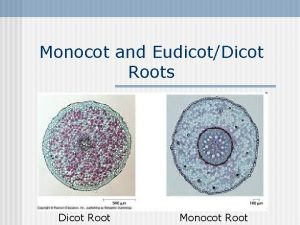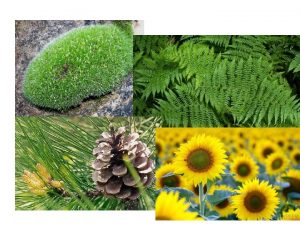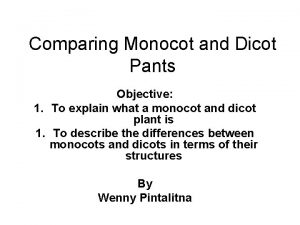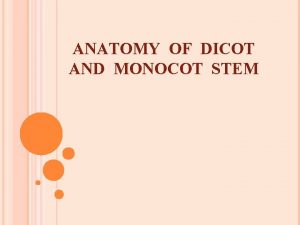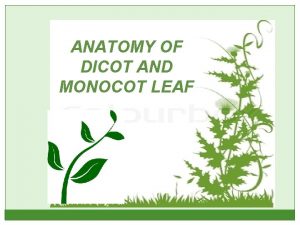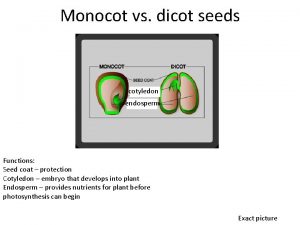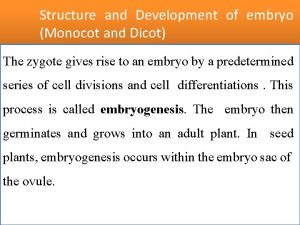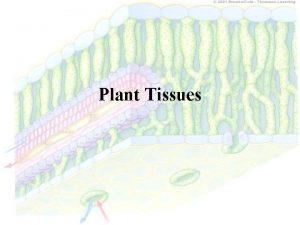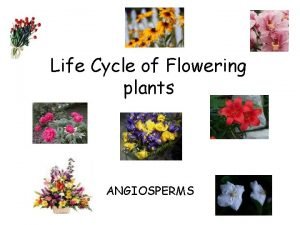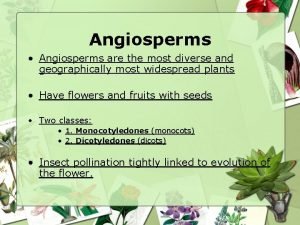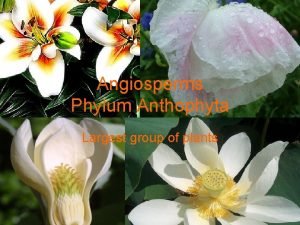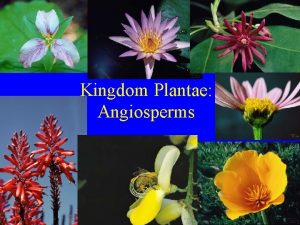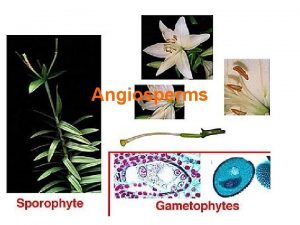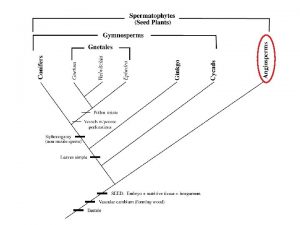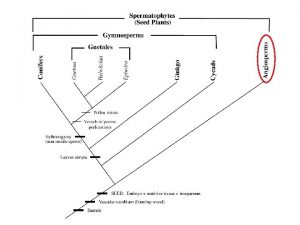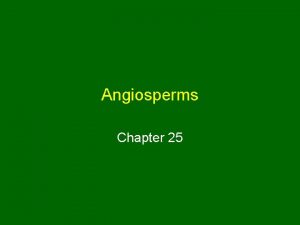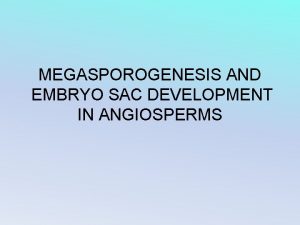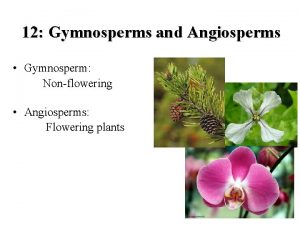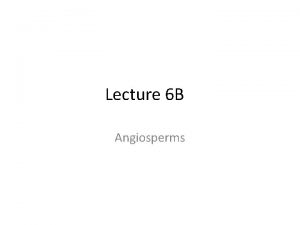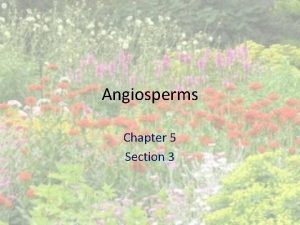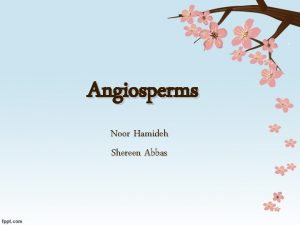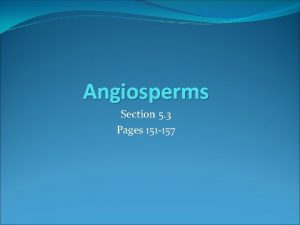Types of Angiosperms I Monocot vs Dicot A







































- Slides: 39

Types of Angiosperms

I. Monocot vs. Dicot A. Cot refers to the cotyledon or seed leaf B. Monocots – one cotyledon (seed leaf) C. Dicots – two cotyledons

D. Leaf types 1. monocots = parallel leaf venation 2. dicots = net venation

E. Flower parts 1. monocots = multiples of 3 2. dicots = multiples of 4 or 5

F. Stem vascular bundles 1. monocots = scattered 2. dicots = form a ring

G. Root types 1. monocots = most have fibrous roots 2. dicots = most have tap roots

H. Bark 1. monocots = rare 2. dicots = common a. dicots with bark called woody plants b. layers of vascular tissue form wood.

II. Woody vs Herbaceous A. Herbaceous plants 1. only produce primary growth =grow taller 2. green stems 3. die back after 1 year a. die completely = annual plants b. grow back from root = perennial plants

B. Woody plants 1. produce secondary growth =grow wider 2. develop bark 3. live multiple years

III. How Plants Grow A. Plants grow by mitosis B. only certain cells in a plant can do mitosis 1. the cells must be undifferentiated 2. differentiated cells have specialized into a. mesophyll cells that do photosynthesis b. xylem cells that transport water c. phloem cells that transport sugar 3. cells that can do mitosis to grow the plant are called meristem cells

4. Apical meristem is in the tips of roots/shoots a. makes shoots/roots grow longer b. after cells divide they grow then differentiate into specialized cell types

5. lateral meristem forms rings around the stem & lets plants grow wider. a. cork cambium = meristem that makes cork cells 1. cork cells die and form bark

b. vascular cambium = meristem that makes vascular tissue 1. phloem on outside 2. xylem on inside

C. Bark = phloem, cork cambium & cork (dead cell layers of epidermis)

A. Girdling = removing bark all around a tree trunk 1. kills trees: no phloem if bark is gone so roots die 2. done by herbivores like rabbits 3. done by humans (sometimes on purpose) a. to make a barrier against diseases

4. Done by parasites : Emerald Ash Borer a. invasive species from Asia b. introduced on wood pallets w/ bark c. Adults: shiny green beetles d. eggs laid on bark in summer e. larvae burrow into bark: eat phloem f. pupate in surface xylem g. adults chew D-shaped hole to exit

h. Biological Control 1. using living things to control pest species 2. parasitoid wasps being tested in Michigan 3. Bill Ravlin, MSU 4. Dan Kashian, Wayne State University

IV. How Seeds Grow A. Dehydrated seeds: metabolism so slow seem dead 1. Keeps seed from sprouting too soon 2. allows seed to travel or survive winter B. Germination – seed begins to grow 1. Triggered by environmental factors 2. Temp: species have temp range for germination 3. Water always required a. Imbibition: plants imbibe water b. water activates dehydrated enzymes c. seed begins to grow…unless it is dormant

C. Chemically induced dormancy 1. abscisic acid (ABA)hormone induces dormancy a. ABA also closes stomata b. causes senescence of leaves (death) i. cells to export ions, sugars, nutrients ii. water follows by osmosis result: iii. apoptosis…programmed cell death 2. Imbibing water activates enzymes that break down ABA allowing seed to germinate

D. Water impermeability dormancy 1. seed coat prevents imbibition 2. seed coat must be damages to let in water a. animals breaking shell & not eating seed b. passing through digestive system c. fire d. freezing/ thawing 3. After seed coat is breached water imbibed 4. Germination ABA break down can proceed

E. Oxygen – required once seed coat breaks 1. Seeds may begin germination using anaerobic respiration 2. To complete germination seed coat must break and let in oxygen for aerobic respiration 3. Soil saturated by water may have too little oxygen causing seedling to die

F. Light– required for some seeds to germinate 1. thin seed coat lets light in 2. may require set day length - keeps from germinating too early 3. may require set wavelength - keeps from germinating in the shade 4. very small seeds no light indicates - too deep in soil to survive germination

G. Temperature fluctuations 1. hydration followed by freezing required 2. keeps from germination in fall or too early

V. Monocot Seed Germination

V. Monocot Seed Germination A. Radicle emerges 1 st 1. becomes primary root 2. adventitious roots form B. primary shoot emerges 2 nd 1. protective coleoptile pushes through soil 2. when coleoptile reaches surface , the first foliage leaves break through it to open C. cotyledon : 1. transfers nutrient from endosperm to growing embryo 2. remains under ground until used up


VI: Dicot Seed Germination A. Radicle emerges first becomes primary root B. Hypocotyl emerges & forms arch 1. pulls leaves/ cotyledons through soil C. Cotyledons absorb nutrients of endosperm 1. transfer nutrients to growing embryo 2. often emerge and turn green (seed leaves) D. Cotyledons open 1. exposure to light causes apical meristem to begin enlarging primary leaves of embryo

VII. Wood Production – Temperate Forest A. first year trees have only PRIMARY XYLEM B. Tree are DORMANT in winter (not growing) C. In spring, APICAL MERISTEM starts growing in buds 1. Apical meristem makes a growth hormone (AUXIN) 2. Auxin diffuses down the trunk 3. Signals VASCULAR CAMBIUM meristem 4. VASCULAR CAMBIUM cells start doing mitosis, making a. XYLEM (inside) b. PHLOEM (outside)

D. Annual Growth Rings – Temperate Forest 1. Spring = lots of water so … a. rapid growth b. large xylem cells c. less dense wood with lighter color 2. Summer = less water so… a. slower growth b. smaller xylem cells c. more dense wood with darker color

E. Annual Growth Rings – Desert 1. Annual Rings can be used to estimate a. annual rainfall b. summer temperatures 2. Bristle Cone Pines of Great Basin Desert a. live thousands of years (oldest = 5, 602 years) b. match living trees with ancient wood i. climate data from 8, 200 years ago

dfd

F. Irregular Annual Rings 1. Tension Rings – one side grows more than other a. bends trunk or branch upward b. pulls on trunk/branch to make it curve up c. angiosperm trees do this


2. Compression Rings – bottom side grows more a. bends trunk or branch upward by pushing b. gymnosperm trees do this

G. Sap Wood vs. Heart Wood 1. only outer layers of xylem still conduct water a. called sap wood b. lighter color

2. inner layers become filled with 3 types of compound that resist rot = Heart Wood a. gums – polysaccharide / glycoprotein - block bacteria / viruses from cuts - plug up xylem vessels -gum Arabic (acacia gum): harvested -edible emulsifying agent - gummy candy, icing, gum, pop - envelopes, ceramic glaze - mummies - major export of Sudan


b. Resins – i. volatile compounds: essential oils: fragrances insecticides/fungicides : turpentine, mint attract parasitoids: frankincense & myrrh ii. hardening agent: varnish, iii. rosin – solidified resin iv. amber = fossilized resin

c. tannins– Tannenbaum (high German Tanna : fir tree) i. anti-microbial, precipitate proteins ii. Acidic, foul tasting, inhibit nutrient absroption iii. Cause wine to be dry iv. Dark color v. used to tan leather
 Angiosperms are monocot or dicot
Angiosperms are monocot or dicot Colocasia is monocot or dicot
Colocasia is monocot or dicot Difference between monocot and dicot
Difference between monocot and dicot Monocot vs eudicot
Monocot vs eudicot Origin of vascular cambium
Origin of vascular cambium Monocot fruits vs. dicot fruits
Monocot fruits vs. dicot fruits Water lily monocot or dicot
Water lily monocot or dicot Pine leaves
Pine leaves Siphonstele
Siphonstele Is coconut a monocot or dicot
Is coconut a monocot or dicot Female parts of flowers
Female parts of flowers Fabaceae monocot or dicot
Fabaceae monocot or dicot Propagative roots
Propagative roots Which plant?
Which plant? Rhizoid
Rhizoid Gymnosperms and angiosperms
Gymnosperms and angiosperms Cross section of anther
Cross section of anther Angiosperms double fertilization
Angiosperms double fertilization Lycophyta
Lycophyta Covered seed
Covered seed Tomato asexual reproduction
Tomato asexual reproduction Angiosperm life cycle
Angiosperm life cycle Plant body of angiosperms
Plant body of angiosperms Apomixis and polyembryony
Apomixis and polyembryony Double fertilization in angiosperms
Double fertilization in angiosperms Partes
Partes Double fertilization in angiosperms
Double fertilization in angiosperms Are angiosperms seedless vascular plants
Are angiosperms seedless vascular plants Bicollateral
Bicollateral Angiosperms
Angiosperms Angiosperms
Angiosperms Angiosperms
Angiosperms Angiosperms
Angiosperms Moss fern gymnosperm angiosperm
Moss fern gymnosperm angiosperm Dicot seed germination diagram
Dicot seed germination diagram Dicot meaning
Dicot meaning Longitudinal section of dicot root
Longitudinal section of dicot root Dicot characteristics
Dicot characteristics Leaf abscission
Leaf abscission Structure that will become the fruit
Structure that will become the fruit
